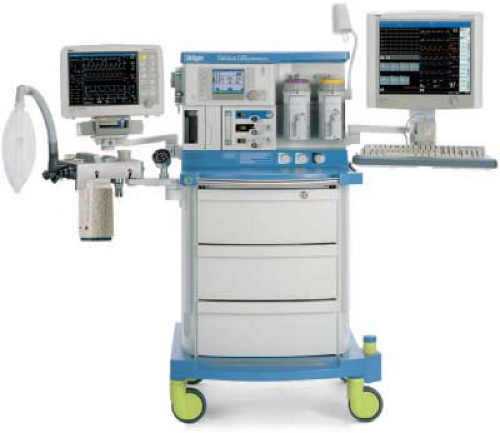The Anesthesia Workstation and Delivery Systems for Inhaled Anesthetics
Modern anesthesia machines are properly referred to as anesthesia workstations (Riutort KT, Btull SJ, Eisenkraft JB. The anesthesia workstation and delivery systems for inhaled anesthetics. In: Barash PG, Cullen BF, Stoelting RK, Cahalan MK, Ortega R, Stock MC, eds. Clinical Anesthesia. Philadelphia: Lippincott Williams & Wilkins; 2013:641–696). The anesthesia workstation is a system for administering anesthetics to patients. The workstation consists of the anesthesia gas supply device, the anesthesia ventilator, monitoring devices, and protection devices (designed to prevent hazardous output caused by incorrect delivery or barotrauma).
I. Anesthesia Workstation Standards and Pre-Use Procedures
Workstations may have computer-assisted self-tests that automatically perform all or part of the pre-use machine checkout procedure. Ultimately, performing adequate pre-use testing of the anesthesia workstation is the responsibility of the individual.
II. Standards for Anesthesia Machines and Workstations
These standards provide guidelines to manufacturers regarding minimum performance, design characteristics, and safety requirements for anesthesia machines. To comply with the American Society for Testing and Materials Standards, newly manufactured workstations must have monitors to measure specific parameters and possess a prioritized alarm system (Table 24-1).
III. Failure of Anesthesia Equipment
The most common malfunction of the medical-gas delivery system is related to the breathing circuit. Pulse oximetry is the principal monitor for alerting the anesthesia professional to an equipment problem.
Table 24-1 American Society for Testing and Materials Standards for Manufactured Workstations | |
|---|---|
|
V. Checkout of the Anesthesia Workstation
A complete anesthesia apparatus checkout procedure must be performed each day before the first use of the anesthesia workstation. (a “machine checklist” is most applicable to older anesthesia machines.) Newer workstations may perform an automated checkout. The three most important preoperative checks are O2 analyzer calibration, the low-pressure circuit leak test, and the circle system test (Table 24-3).
Table 24-2 Comparison of Anesthesia Workstation Functions | ||||||||||||||||||||||||||||||||||||||||||||||||||||||||||||||||||||||||||||||||||||||||||||||||||||||
|---|---|---|---|---|---|---|---|---|---|---|---|---|---|---|---|---|---|---|---|---|---|---|---|---|---|---|---|---|---|---|---|---|---|---|---|---|---|---|---|---|---|---|---|---|---|---|---|---|---|---|---|---|---|---|---|---|---|---|---|---|---|---|---|---|---|---|---|---|---|---|---|---|---|---|---|---|---|---|---|---|---|---|---|---|---|---|---|---|---|---|---|---|---|---|---|---|---|---|---|---|---|---|
| ||||||||||||||||||||||||||||||||||||||||||||||||||||||||||||||||||||||||||||||||||||||||||||||||||||||
Table 24-3 Preoperative Anesthesia Workstation Checklist | |
|---|---|
|
VI. Anesthesia Workstation Pneumatics
The Anatomy of an Anesthesia Workstation (Fig. 24-1)
Gases such as O2, nitrous oxide (N2O), and air are usually supplied from a central pipeline with cylinders on the machine as a backup. The pipeline source is usually at 50 psig (pounds per square inch gauge). A full O2 cylinder contains only gas, and the tank pressure decreases linearly from a maximum of about 2,200 psig as it is consumed. N2O is compressed to a liquid in tanks and maintains a pressure of 745 psig until all the liquid is dissipated.
Oxygen failure cutoff (“fail safe”) valves are located downstream from the N2O supply source and serve as an interface between the O2 and N2O supply sources. This value shuts off or proportionally decreases the supply of N2O if the O2 of supply decreases.
Regulators downstream from the O2 supply source adjust the pressure to about 14 psig before entering the flow meter assembly.
Flow control valves separate the intermediate-pressure circuit from the low-pressure circuit (the part of the machine that is downstream from the flow control valves). The operator regulates flow entering the low-pressure circuit by adjusting the flow control valves. After leaving the flow tubes, the mixture of gases travels through a common manifold and may be directed to a calibrated vaporizer.
A one-way check valve located between the vaporizer and common gas outlet prevents backflow into the vaporizer during positive pressure ventilation.
The O2 flush connection joins the mixed-gas pipeline between the one-way check valve and the machine outlet. When the O2 flush valve is activated, the pipeline O2 pressure is reflected in the common gas outlet.
Pipeline Supply Source. Most hospitals have a central piping system to deliver medical gases such as O2, N2O, and air to the operating room at appropriate pressures for the anesthesia workstation to function properly.
Cylinder Supply Source. Anesthesia workstations have E cylinders for use when a pipeline supply source is not available or if the pipeline system fails.
An E cylinder of O2 with a pressure of 1,000 psig and used at 5 L/min would be depleted in 1 hour.
A regulator for E cylinders of O2 is available that permits controlled delivery of oxygen via a nozzle at flows of <25 L/min for patient transport.
A full tank of N2O generates approximately 1,600 L of gas, and as long as some liquid is present in the tank, the pressure remains 750 psig. (Gas available cannot be determined from the tank pressure gauge.)
Flowmeter assemblies precisely measure gas flow to the common gas outlet. Depending on the setting of the flow control valve, gases flow through variable orifice, tapered tubes at a rate indicated by the position of a float indicator in relation to a calibrated scale.
At low flow rates, the viscosity of the gas is dominant in determining flow; density is dominant at high flow rates.
Safety features include the use of standardized colors for each gas, an O2 flow meter dial that is distinct from the others, and positioning of the O2 flow meter immediately proximal to the common gas outlet to minimize the chance of delivery of hypoxic mixtures in the event of leaks in the flow meter assembly.
Full access? Get Clinical Tree









